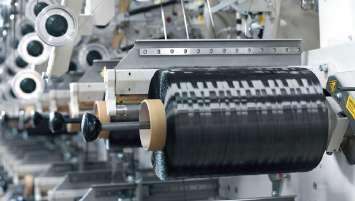42
DIGITAL PRINTING
DIGITAL TEXTILE PRINTING Dr.N.N. MAHAPATRA Business Head (Dyes) SHREE PUSHKAR CHEMICALS & FERTILISERS LTD. At present the textile industry produces the majority of its 34 billion square yards of printed textile fabric by screen printing. However as we move into the digital age developments in digital printing of paper are being adapted more and more for the textile market. Inkjet textile printing is growing while growth in analog textile printing remains stagnant. As digital print technologies improve offering faster production and larger cost-effective print runs, digital printing will grow to become the technology that provides the majority of the world’s printed textiles. Digital technology is the fastest growing method of printing textiles, according to a report in the latest issue of Textile Outlook International. Between 2000 and 2005 digitally printed textile output rose by 300% to 70m square metres. Although digital methods still account for less than 1% of the global market for printed textiles, their share is likely to expand to as much as 10% by the early part of the next decade. Screen printing still dominates the textile printing market with 80% of global output. However, this share is expected to fall as digital printing gains more of a foothold in the market. One reason for the expected growth in digital printing is that more textile manufacturers are able to provide “prepared for print” (PFP) fabrics to digital printers. But much of the increase will be due to improvements in digital printing equipment, such as printheads and ink dispersion techniques. Growth will also stem from advances in pigment-based inks. The inkjet textile printing technology has been rapidly getting accepted in the past few years. The history of applying inkjet to textile printing is rather long, as an alternative convenient method to conventional printing technology. It was expected to be suitable for quick delivery, short-run production and photographic
print with multi-level tone reproduction, which is difficult to achieve with existing analog technology. Some advanced users have already used inkjet for years to manufacture a wide variety of products, mainly for short-run production or sample-making. Recently, however, improved reliability of inkjet printers, along with the introduction of digital technology in design process has made this technology a realistic option to be utilized for massproduction. Market expectation for more productive inkjet textile printer has also contributed to this new trend. Digital Textile Printing in nature is quite separate from traditional Textile Printing, that is the reason why digital textile printing is often termed as “the next generation printing”. Novel techniques in textile printing create new opportunities in business. As technology advanced in the printing process, color inkjet printers became a vital part in the printing process of the fabric market as well. Utilizing the advantages of the digital printing technology, this is a process of printing on textiles and garments, through specialized or modified inkjet technology. It is done by using an inkjet printer and using fabric sheets with a removable paper backing. A transport mechanism for the fabric, and special textile inks are applied to textiles directly and are absorbed by the fibres. Digital textile printing is an excellent reflection or original artworks with a right blend of classic and elegant view. Also known as direct to garment printing, the process prints designs on fabrics from the computer without any other sources like designing on paper and printing. It enables for changes in color and design easily, and quickly prior to printing. This technology offers faster production technology, cost effective print runs, and provides majority of the worlds printed textiles. This process consumes less water, and dyes, thereby proving to be environmen-
SEPTEMBER 2021
tally friendly. Family photos too can be used for digital printing on the fabric of ones own choice. Consumers of today are more demanding with specific choices relating to style, design, and color combinations. This business enables quick turn-around, economic and flexible, efficient set-up and speed. Main advantage of this process is color applications through latest printers, and software applications. Recent concepts of shimmering, shadow, reflection, blurring, layering, and superimposing is also possible through digital fabric printing. The art of digital printing has influenced both the style and process of textile printing. Digital textile printing has realigned conventional textile printing processes with innovation, and technological advancement. The dyes used for digital textile printing are different from the dyes used in traditional printing. The most popular dyes for digital printing are acid dye, reactive dye and disperse dye. These dyes can be used for all commercial applications, and have properties like bright colors, low to medium salt content and high color fastness. Various dyes are used depending on the fabric for digital printing, like acid inks are used on silk and nylon; disperse inks on polyesters and reactive inks are used on all cellulose based fabrics such as cotton, linen and rayon. Moreover, these dyes are compatible with low cost ink systems. Colour Pigment Dispersion are premium quality aqueous suspensions of organic pigments in water. They impart bright and clean colors and a very fine particle size distribution enhances performance. They give high performances in thermal and piezo inkjet application. Essential Features • A very stable dispersion. • Perfectly applicable for both indoor and





















